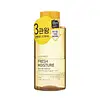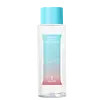What's inside
What's inside
 Key Ingredients
Key Ingredients

 Benefits
Benefits

 Concerns
Concerns

 Ingredients Side-by-side
Ingredients Side-by-side

Water
Skin ConditioningCyclopentasiloxane
EmollientCocos Nucifera Oil
MaskingHexylene Glycol
EmulsifyingSodium Chloride
MaskingCoco-Caprylate/Caprate
EmollientLauryl Methyl Gluceth-10 Hydroxypropyldimonium Chloride
1,2-Hexanediol
Skin ConditioningPotassium Phosphate
BufferingCaprylyl Glucoside
CleansingDisodium EDTA
Ethylhexylglycerin
Skin ConditioningDipotassium Phosphate
BufferingButylene Glycol
HumectantCitrus Junos Peel Extract
Skin ConditioningTocopherol
AntioxidantWater, Cyclopentasiloxane, Cocos Nucifera Oil, Hexylene Glycol, Sodium Chloride, Coco-Caprylate/Caprate, Lauryl Methyl Gluceth-10 Hydroxypropyldimonium Chloride, 1,2-Hexanediol, Potassium Phosphate, Caprylyl Glucoside, Disodium EDTA, Ethylhexylglycerin, Dipotassium Phosphate, Butylene Glycol, Citrus Junos Peel Extract, Tocopherol
Water
Skin ConditioningCyclopentasiloxane
EmollientDipropylene Glycol
HumectantIsododecane
EmollientSodium Chloride
MaskingPentylene Glycol
Skin ConditioningHydrogenated Poly(C6-14 Olefin)
EmollientHydrogenated Polyisobutene
Emollient1,2-Hexanediol
Skin ConditioningCaprylyl Glycol
EmollientCaprylyl/Capryl Glucoside
CleansingChlorella Vulgaris Extract
Skin ConditioningGlucose
HumectantButylene Glycol
HumectantFructooligosaccharides
HumectantFructose
HumectantEthylhexylglycerin
Skin ConditioningGlycerin
HumectantDipotassium Glycyrrhizate
HumectantDisodium EDTA
Glycine Soja Seed Extract
Skin ConditioningOctanediol
Tocopherol
AntioxidantSodium Hyaluronate
HumectantOryza Sativa Bran Oil
EmollientPrunus Armeniaca Kernel Oil
MaskingCaprylic/Capric Triglyceride
MaskingChamomilla Recutita Flower Extract
MaskingWater, Cyclopentasiloxane, Dipropylene Glycol, Isododecane, Sodium Chloride, Pentylene Glycol, Hydrogenated Poly(C6-14 Olefin), Hydrogenated Polyisobutene, 1,2-Hexanediol, Caprylyl Glycol, Caprylyl/Capryl Glucoside, Chlorella Vulgaris Extract, Glucose, Butylene Glycol, Fructooligosaccharides, Fructose, Ethylhexylglycerin, Glycerin, Dipotassium Glycyrrhizate, Disodium EDTA, Glycine Soja Seed Extract, Octanediol, Tocopherol, Sodium Hyaluronate, Oryza Sativa Bran Oil, Prunus Armeniaca Kernel Oil, Caprylic/Capric Triglyceride, Chamomilla Recutita Flower Extract
Ingredients Explained
These ingredients are found in both products.
Ingredients higher up in an ingredient list are typically present in a larger amount.
1,2-Hexanediol is a synthetic liquid and another multi-functional powerhouse.
It is a:
- Humectant, drawing moisture into the skin
- Emollient, helping to soften skin
- Solvent, dispersing and stabilizing formulas
- Preservative booster, enhancing the antimicrobial activity of other preservatives
Butylene Glycol (or BG) is used within cosmetic products for a few different reasons:
Overall, Butylene Glycol is a safe and well-rounded ingredient that works well with other ingredients.
Though this ingredient works well with most skin types, some people with sensitive skin may experience a reaction such as allergic rashes, closed comedones, or itchiness.
Learn more about Butylene GlycolCyclopentasiloxane, or D5, is a silicone used to improve texture of products and trap moisture.
D5 is considered lightweight and volatile. Volatile means it evaporates quickly after application. Once evaporated, D5 leaves a thin barrier that helps keep skin hydrated.
It is also an emollient. Emollients help soften the skin and prevent water loss. Silicones create a silky texture in products. D5 helps other ingredients become more spreadable.
Studies show D5 is safe to use in skincare products. We recommend speaking with a skincare professional if you have concerns.
Learn more about CyclopentasiloxaneDisodium EDTA plays a role in making products more stable by aiding other preservatives.
It is a chelating agent, meaning it neutralizes metal ions that may be found in a product.
Disodium EDTA is a salt of edetic acid and is found to be safe in cosmetic ingredients.
Learn more about Disodium EDTAEthylhexylglycerin (we can't pronounce this either) is commonly used as a preservative and skin softener. It is derived from glyceryl.
You might see Ethylhexylglycerin often paired with other preservatives such as phenoxyethanol. Ethylhexylglycerin has been found to increase the effectiveness of these other preservatives.
Chances are, you eat sodium chloride every day. Sodium Chloride is also known as table salt.
This ingredient has many purposes in skincare: thickener, emulsifier, and exfoliator.
You'll most likely find this ingredient in cleansers where it is used to create a gel-like texture. As an emulsifier, it also prevents ingredients from separating.
There is much debate on whether this ingredient is comedogenic. The short answer - comedogenic ratings don't tell the whole story. Learn more about comegodenic ratings here.
The concensus about this ingredient causing acne seems to be divided. Research is needed to understand if this ingredient does cause acne.
Scrubs may use salt as the primary exfoliating ingredient.
Learn more about Sodium ChlorideTocopherol (also known as Vitamin E) is a common antioxidant used to help protect the skin from free-radicals and strengthen the skin barrier. It's also fat soluble - this means our skin is great at absorbing it.
Vitamin E also helps keep your natural skin lipids healthy. Your lipid skin barrier naturally consists of lipids, ceramides, and fatty acids. Vitamin E offers extra protection for your skin’s lipid barrier, keeping your skin healthy and nourished.
Another benefit is a bit of UV protection. Vitamin E helps reduce the damage caused by UVB rays. (It should not replace your sunscreen). Combining it with Vitamin C can decrease sunburned cells and hyperpigmentation after UV exposure.
You might have noticed Vitamin E + C often paired together. This is because it is great at stabilizing Vitamin C. Using the two together helps increase the effectiveness of both ingredients.
There are often claims that Vitamin E can reduce/prevent scarring, but these claims haven't been confirmed by scientific research.
Learn more about TocopherolWater. It's the most common cosmetic ingredient of all. You'll usually see it at the top of ingredient lists, meaning that it makes up the largest part of the product.
So why is it so popular? Water most often acts as a solvent - this means that it helps dissolve other ingredients into the formulation.
You'll also recognize water as that liquid we all need to stay alive. If you see this, drink a glass of water. Stay hydrated!
Learn more about Water